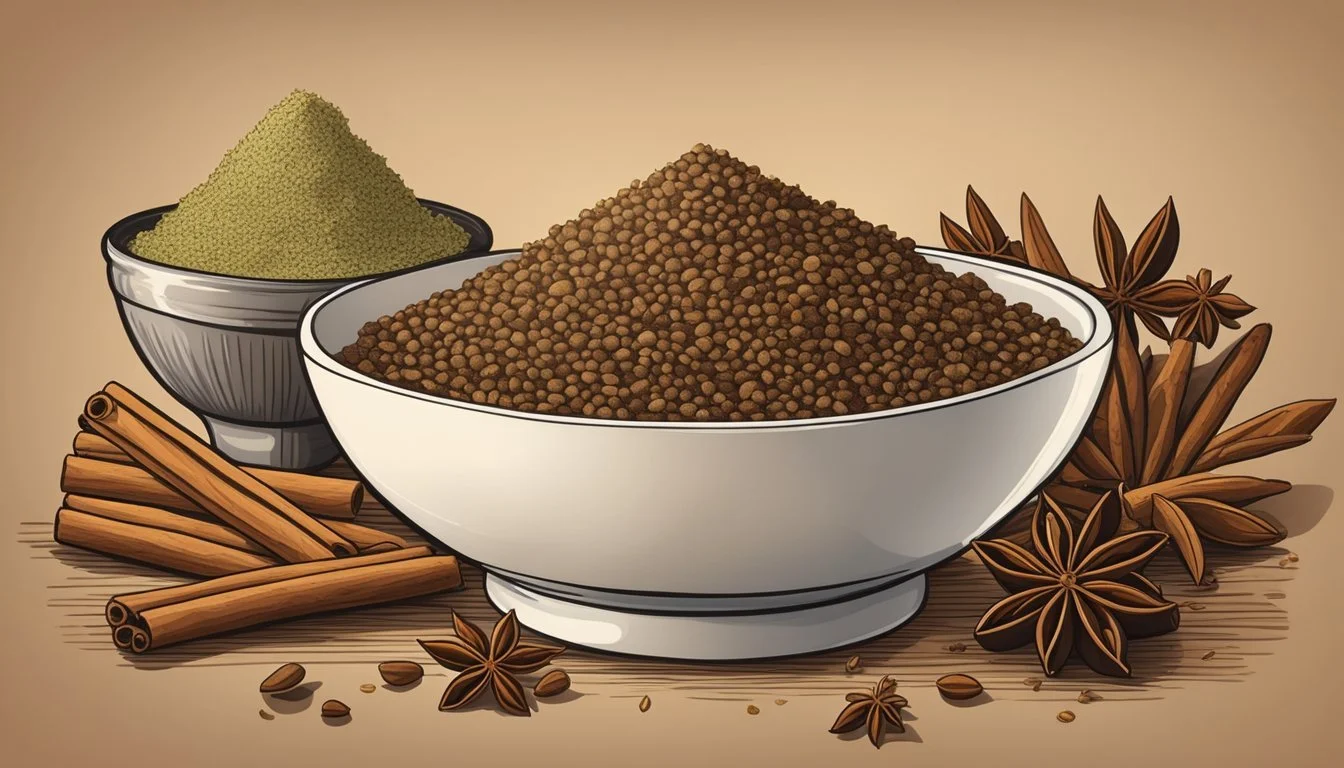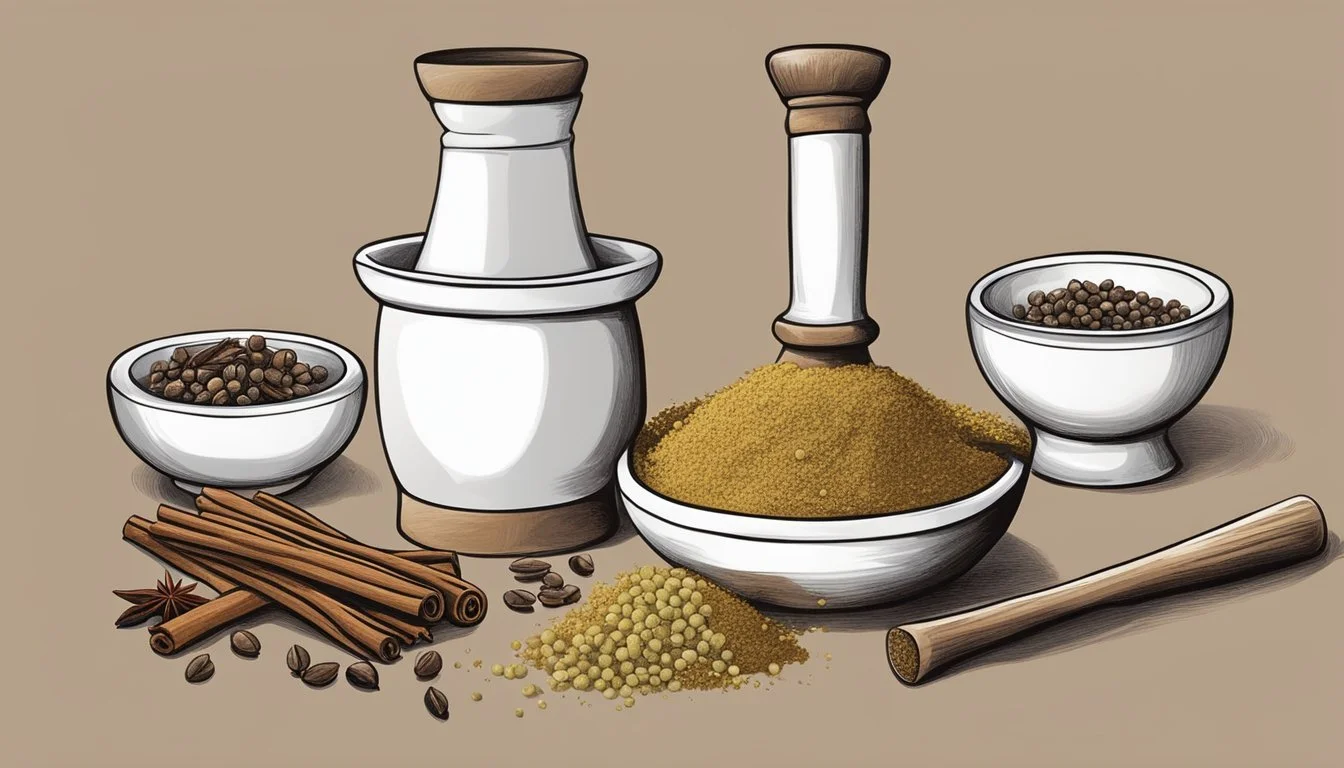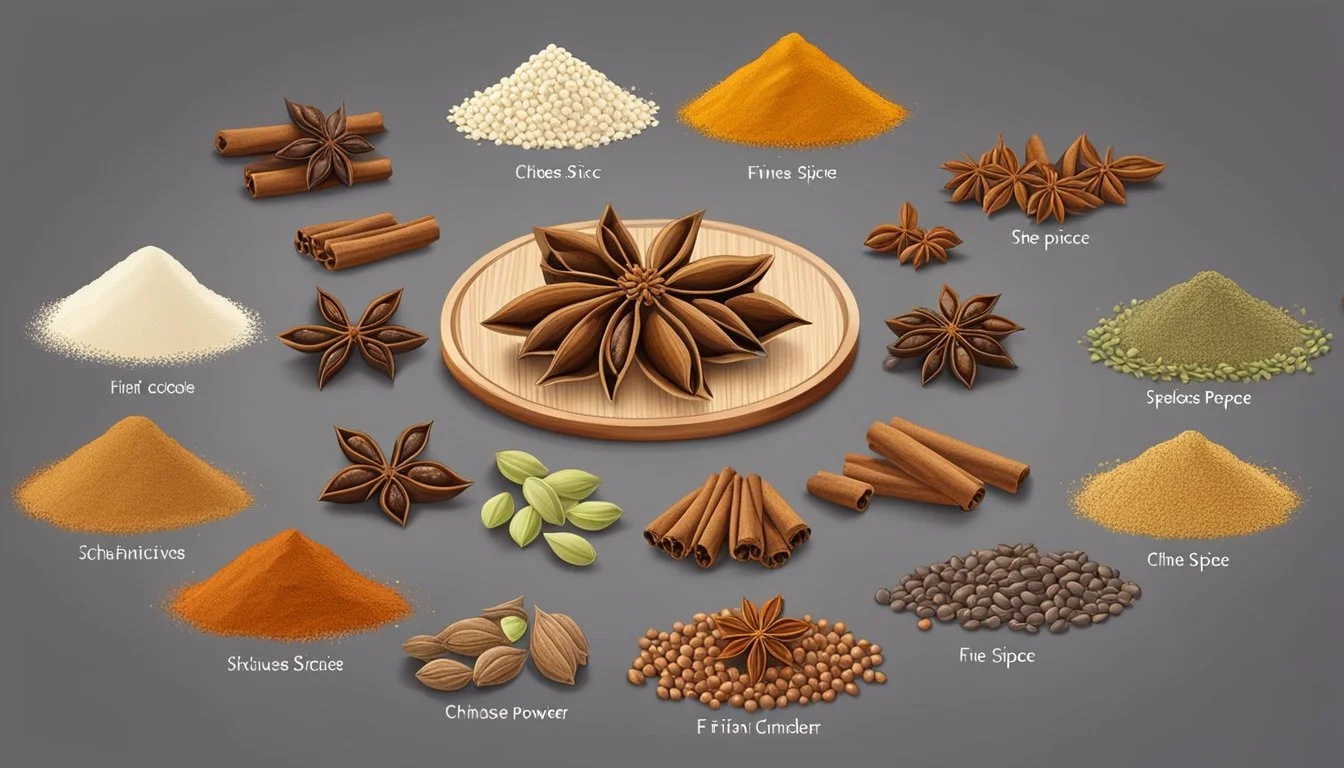Chinese Five Spice Powder Substitutes
Top Alternatives for Your Pantry
Chinese Five Spice Powder is a staple blend in Chinese and Taiwanese cuisines, treasured for its ability to incorporate the five key flavors of sweet, sour, bitter, salty, and umami. Its unique combination typically includes star anise, cloves, Chinese cinnamon, Sichuan pepper, and fennel seeds. These ingredients work in harmony to create a balance in flavor that is integral to many Asian dishes. However, not everyone may have this spice blend readily available in their pantry, or they may be looking to avoid certain ingredients due to dietary restrictions or flavor preferences.
Finding a suitable substitute for Chinese Five Spice can be a challenge, as its distinct flavor is hard to replicate with a single spice. However, several alternatives utilize common kitchen spices and can mimic the complex character of the original blend. For instance, mixing ground anise with cinnamon, cloves, and pepper can deliver a similar aromatic quality. Garam masala, a well-known Indian spice mix, can also serve as an unexpected but effective alternative when star anise is added to enhance its flavor profile.
When experimenting with these substitutes, the key is to understand the individual flavors of the spices being combined and how they complement each other. Each alternative mix brings a different dimension to dishes, which can be tailored according to personal taste and the specific requirements of the recipe at hand. Through careful selection and blending of spices, cooks can achieve a harmony of flavors that embodies the essence of Chinese Five Spice, even when the original ingredients are not all present.
Understanding Chinese Five-Spice Powder
Chinese Five-Spice Powder is a staple in Asian cooking, revered for its ability to impart a complex flavor profile to a variety of dishes. It traditionally encompasses the five basic flavors of Chinese culinary philosophy: sweet, bitter, sour, salty, and umami. This blend creates a harmonious taste experience that enhances the overall flavor of a dish without overpowering individual components.
The quintessential ingredients of Chinese Five-Spice Powder include:
Star Anise: Adds a licorice-like sweetness and is often the predominant flavor.
Cloves: Contribute a pungent bitterness that adds depth.
Fennel Seeds: Known for their light sweetness, reminiscent of anise.
Sichuan Peppercorns: Introduce a unique tanginess and a slight numbing quality, touching upon the sour aspect.
Cinnamon: Provides a comforting warmth and sweetness.
Spice Flavor Note Star Anise Sweet Cloves Bitter Fennel Seeds Sweet Sichuan Peppercorns Sour Cinnamon Sweet
The balance of these flavors is central to the five-spice's unique taste, with each ingredient carefully measured to ensure a perfect blend. While proportions can vary slightly depending on the recipe or the region, the integrity of the five distinct tastes is always maintained. This powder is typically used sparingly to season meats, stews, and marinades, enhancing the dishes with its aromatic and captivating essence.
Common Uses of Chinese Five-Spice Powder
Chinese Five-Spice Powder is a foundational seasoning in Asian cuisine, renowned for its ability to impart a complex array of flavors. This versatile blend is typically composed of star anise, cloves, Chinese cinnamon, Sichuan peppercorns, and fennel seeds, which together balance the five key flavor profiles: sweet, bitter, salty, sour, and umami.
In Chinese cooking, the spice is often incorporated into marinades for various meats, such as pork, duck, and chicken. The aromatic qualities of the spice blend penetrate the meat, enhancing its natural flavors. It is not uncommon to find five-spice powder used in the preparation of char siu (barbecued pork) or Peking duck, offering a warm, spicy undertone to the dishes.
Stews and soups in Asian cuisine also frequently feature Chinese Five-Spice Powder. A small quantity can profoundly influence the overall taste profile of a dish, bringing a harmonious blend to the savory broth. Additionally, it serves as an excellent rub for meats, either on its own or when mixed with other ingredients like salt and sugar to create a flavorful crust.
Here's a quick reference to its uses:
Marinades: Enhances flavor depth in meat dishes.
Stews: Imparts a warm, comforting aroma and taste.
Soups: Adds a multi-dimensional flavor with minimal effort.
Rub: Creates a distinctive outer seasoning for meats before cooking.
Five-Spice Powder holds a symbolic place within Chinese cuisine, representing the balance of Yin and Yang through its flavor harmony. Aside from traditional Chinese dishes, its use has spread across various Asian culinary practices, demonstrating its versatility in a multitude of recipes.
Key Components of Chinese Five-Spice Powder
Chinese Five-Spice Powder is a blend of spices crucial to many Chinese culinary traditions, embodying a balance of the five essential flavors. Here are the primary ingredients:
Star Anise: It imparts a licorice-like, warm flavor.
Chinese Cinnamon: Also called "cassia," this is sweeter and more potent than common cinnamon.
Fennel Seeds: These seeds add a sweet, anise-like taste.
Sichuan Pepper: Not true peppercorns, these husks offer a lemony flavor and a unique numbing sensation.
Cloves: Intensely aromatic, cloves contribute a bitter, sweet depth.
The combination of these spices creates a profile that is at once sweet, bitter, pungent, and aromatic.
Spice Flavor Note Star Anise Licorice-like, warm Chinese Cinnamon Sweet, potent Fennel Seeds Anise-like, sweet Sichuan Pepper Lemony, numbing Cloves Aromatic, sweetly bitter
In recipes, each component contributes a unique aspect, allowing Five-Spice Powder to offer a complex flavor with just a single seasoning. While it is traditionally composed of these five spices, regional variations and personal preferences sometimes introduce additional elements such as ginger or orange peel. However, the core five remain central to its identity.
Primary Substitutes for Chinese Five-Spice Powder
When one is unable to obtain Chinese Five-Spice Powder, several viable alternatives can be employed to emulate its complex, sweet, and warm flavor profile. The substitutes can vary in their ingredients, but they often share common spices that replicate the original blend's character.
Homemade Blend: A tailored mixture can be crafted by toasting equal parts of cinnamon, cloves, and star anise; followed by smaller amounts of fennel seeds and Sichuan peppercorns. Once cooled, these are ground to a fine powder. The balance of these spices is crucial for a close match.
Allspice: Known for its semblance to a few of the five spices, primarily cinnamon and cloves, allspice is an individual spice that offers warmth and sweetness. It lacks the anise and fennel flavor but serves as a quick and accessible substitute in a pinch.
Garam Masala: This Indian blend frequently incorporates cinnamon, cloves, and other warming spices, making it a suitable stand-in. One should adjust the quantity to taste since Garam Masala can be more potent.
Baharat: Middle Eastern in origin, Baharat includes elements like cumin, coriander, and black pepper, alongside cinnamon and cloves. It adds a sweet-spicy touch akin to Chinese Five-Spice, but with subtle differences from regional variations, such as the inclusion of nutmeg or paprika.
Pumpkin Spice Blend: While not a traditional alternative, it can mimic Five-Spice's warm notes through cinnamon, nutmeg, and cloves. It's sweeter due to the absence of savory spices, yet in certain sweet recipes, it can be a delightful stand-in.
Substitute Similar Spices Note on Usage Homemade Blend All Five Requires prep and multiple spices Allspice Cinnamon, Cloves Misses anise and fennel notes Garam Masala Cinnamon, Cloves Adjust for intensity Baharat Cinnamon, Cloves, Nutmeg Includes additional savory spices Pumpkin Spice Cinnamon, Nutmeg, Cloves Best for sweet dishes
These primary substitutes can be adjusted according to the dish's requirements and the spices available in one’s pantry. The choice of alternative should complement the overall flavor of the intended recipe.
Individual Spice Alternatives
When cooking a dish that calls for Chinese Five Spice Powder but without access to it, chefs can consider individual spices as effective alternatives. The key is to mimic the unique balance of sweet, sour, bitter, pungent, and salty flavors that define the traditional blend. Below is a table of individual spices that can be substituted for specific components of Chinese Five Spice:
Chinese Five Spice Ingredient Alternative Spices Star Anise Anise or Fennel Sichuan Peppercorn Black Pepper Cinnamon Chinese Cinnamon (Cassia) Cloves Nutmeg or Mace
Fennel seeds share a similar licorice flavor with star anise, making them a sensible substitution. They lend a sweet taste as well but are milder. To capture star anise’s stronger flavor, one might add a pinch of licorice root if available.
Black pepper can be used in place of Sichuan peppercorn; however, it fails to impart the characteristic tingly numbness associated with Sichuan peppercorn. To somewhat replicate this effect, chefs could potentially mix black pepper with a hint of citrus zest.
For a warm, woody aroma akin to Cinnamon, Chinese cinnamon, also known as cassia, is an acceptable alternative; its flavor profile is more intense and a bit less sweet than true cinnamon.
Substitutions for cloves can be nutmeg or mace, which both add a similar pungent sweetness. Mace, the outer layer of the nutmeg seed, provides a more delicate flavor and is thus preferred if subtlety is desired.
Each of these substitutes offers its unique properties, and thoughtful use can create a symphony of flavors comparable to the original Chinese Five Spice blend.
Homemade Chinese Five-Spice Powder Recipes
Creating a homemade Chinese Five-Spice powder allows one to capture the essence of Chinese cuisine. This aromatic spice blend traditionally comprises five spices, each representing one of the five flavor groups.
Ingredients:
Star anise: imparts a licorice flavor.
Cloves: add a deep, warm tone.
Cinnamon: provides sweet, woody notes.
Fennel seeds: contribute anise-like qualities.
Sichuan peppercorns: offer a unique numbing sensation.
Instructions:
Toast the Spices: Break the star anise and cinnamon into smaller pieces. Toast them in a dry pan over low heat, along with cloves and fennel seeds, until they become fragrant, taking care not to burn them.
Grinding the Spices: After cooling, transfer the spices to a spice grinder or a coffee grinder. Pulse the grinder in short bursts to avoid overheating, which can lead to a loss of flavor. Grind until achieving a fine powder consistency.
Blend Proportions:
Star anise: 6-8 pieces
Cloves: 1 teaspoon
Cinnamon: 1 piece (about 2 inches)
Fennel seeds: 1 teaspoon
Sichuan peppercorns: 1 teaspoon
This mixture should be ground until uniformly fine. For those who cannot find Sichuan peppercorns, they can be omitted, but this will result in a less authentic flavor profile. Similarly, if ground versions of these spices are already on hand, they can be combined in the proportions mentioned above without toasting or additional grinding. The freshly made spice blend can enhance the flavor of meats, stews, and even baked goods. Store the blend in a sealed container, away from heat and light, to maintain its potency.
Additional Spice Blend Substitutes
When looking for alternatives to Chinese five-spice powder, there are several spice blends that can serve as stand-ins to impart a complex and layered flavor to dishes. Each substitute offers a different profile, but they can be used to achieve a similarly rich taste.
Garam Masala: This Indian spice blend can create warmth and depth in recipes. Although not a direct match—the blend lacks star anise and traditionally includes other spices like mace—garam masala can still provide a sweet-spicy kick. To come closer to five-spice's profile, add star anise separately to the dish.
Typical components: Cumin, coriander, cardamom, black pepper, cinnamon, cloves, nutmeg.
Recommended ratio: Start with a half teaspoon of garam masala and a pinch of ground star anise for each teaspoon of five-spice needed.
Ras El Hanout: Hailing from North African cuisine, ras el hanout encompasses a broad spectrum of spices that vary by recipe but usually include several elements common to five-spice.
Typical components: Cardamom, cumin, clove, cinnamon, nutmeg, mace, allspice.
Note: May include more robust flavors like turmeric or ginger.
Za’atar: This Middle Eastern blend is tangier and herbier, featuring sumac and thyme. Za'atar lacks the sweet elements of five-spice but can add a distinctive savory tone to dishes.
Typical components: Sumac, sesame seeds, thyme, oregano.
Pairing suggestion: Mix za’atar with a pinch of cinnamon and cloves to mimic some of five-spice's sweet and warm notes.
Each alternative offers a different experience but with creative application, they can replace five-spice in a pinch. It's important to adjust quantities and component spices based on the desired outcome and the complexity of the dish’s flavor profile.
Culinary Considerations When Substituting
When substituting Chinese Five Spice Powder, chefs should consider how the blend's distinctive flavor can be replicated. Chinese Five Spice is characterized by a balance of sweet, sour, bitter, pungent, and salty tastes. It typically imparts a warm, slightly sweet, and spicy flavor to dishes. Successful substitutes must strive to maintain this harmony.
For meat dishes, where the spice helps create a caramelized crust, one should opt for toasted spices that offer a depth of flavor to replicate the original profile. Toasting spices such as cinnamon, cloves, and star anise enhances their aroma and complements meats well. Fish and poultry can be more delicately flavored, so a lighter hand with substitutes like allspice or garam masala might be suitable to avoid overpowering these proteins.
Table: Substitutes and Their Sensations
Substitute Sensation Provided Toasted Cinnamon Warm, Sweet Star Anise Licorice, Sweet Cloves Pungent, Slightly Bitter Sichuan Pepper Numbing, Tingling Fennel Seeds Mild Licorice
Sichuan pepper is known for its unique numbing and tingling sensations. When including Sichuan pepper in a substitute blend, chefs should consider the desired level of these sensations in the dish, adjusting the quantity accordingly.
It's important to remember that the substitutes should be used in moderation to achieve a comparable flavor profile. Adjusting the quantities of these substitutes is critical based on their potency and the characteristics of the dish.
Cultural Significance of Chinese Five-Spice
The Chinese Five-Spice powder, known as 五香粉 (wǔxiāng fěn) in Mandarin, resonates deeply with the culinary traditions and cultural philosophies of China. This blend, originating from Southern China, is a staple in Chinese cuisine and embodies the essence of balance and harmony that are central to Chinese culture. Each of the spices in the blend contributes to the overall flavor profile and symbolizes one of the five fundamental taste elements - sweet, sour, bitter, spicy, and salty.
In Asian cuisine, particularly Chinese, the five-spice powder has been used not just for its flavor, but also for its purported health benefits. Traditional Chinese Medicine advocates for a balance of the five flavor elements, believing that this balance contributes to better health. Thus, the five-spice powder is more than just a seasoning—it's a link to Chinese heritage and a reflection of ancient wisdom.
Incorporation of Chinese Five-Spice in culinary practices varies, demonstrating regional preferences and historical influences. It is an essential component in numerous dishes, providing a complex, pungent aroma that is instantly recognizable. Its presence in a dish can transform and elevate the flavor profile, making it a beloved ingredient in kitchens across not only China but also the global culinary stage.
The unique blend of spices typically includes:
Star Anise: a sweet, licorice-like spice representing the sweet flavor.
Cloves: with a warm, aromatic intensity representing the bitter aspects.
Chinese Cinnamon: providing a comforting earthiness that contributes the spicy notes.
Fennel Seeds: adding a touch of contrasting sweet and mild spiciness.
Sichuan Peppercorns: introducing a tingling, numbing heat, a representation of the sour note.
As such, Chinese Five-Spice powder is a cultural symbol, encapsulating a fusion of taste sensations that is richly tied to the philosophies of balance and well-being in Chinese culinary culture.







